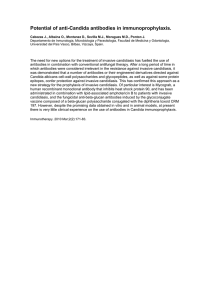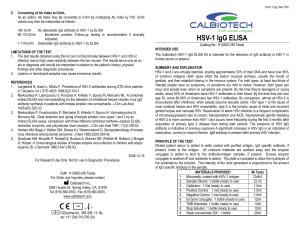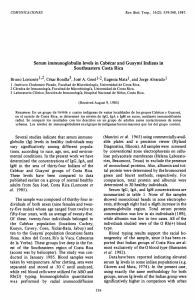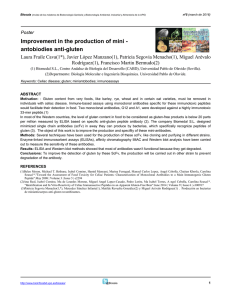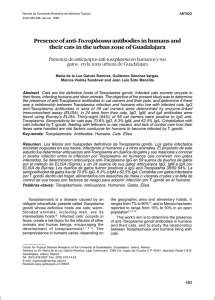Antibodies to Borrelia burgdorferi in European populations
Anuncio
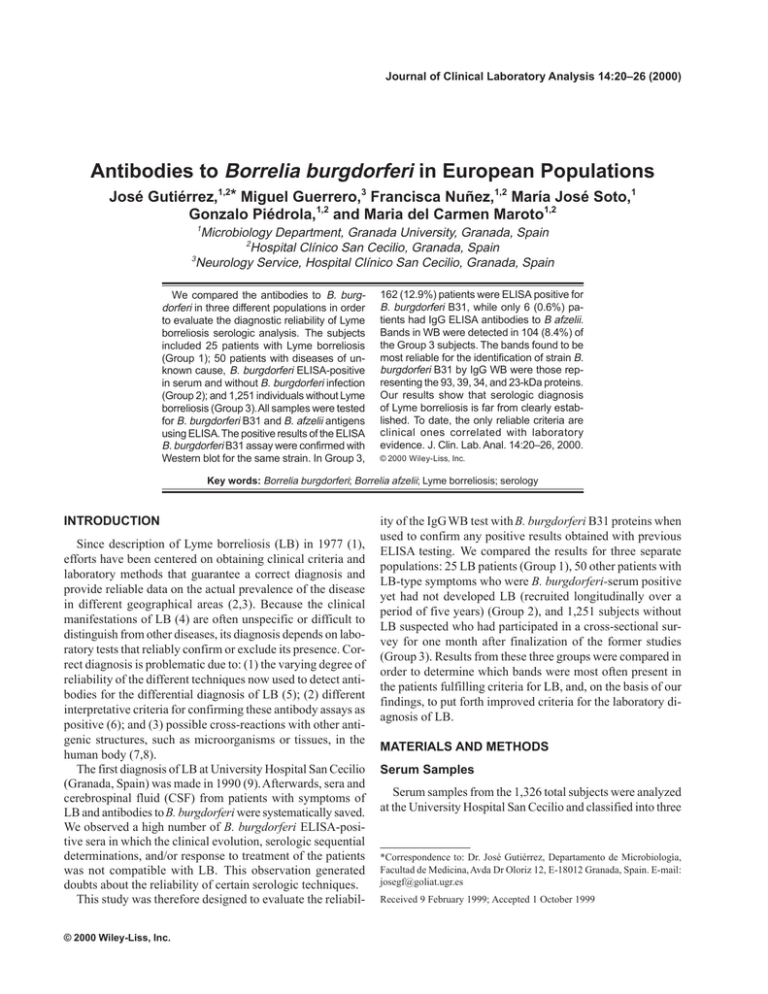
JCLA 1898 20 Gutiérrez et al. Journal of Clinical Laboratory Analysis 14:20–26 (2000) Antibodies to Borrelia burgdorferi in European Populations José Gutiérrez,1,2* Miguel Guerrero,3 Francisca Nuñez,1,2 María José Soto,1 Gonzalo Piédrola,1,2 and Maria del Carmen Maroto1,2 1 Microbiology Department, Granada University, Granada, Spain 2 Hospital Clínico San Cecilio, Granada, Spain 3 Neurology Service, Hospital Clínico San Cecilio, Granada, Spain We compared the antibodies to B. burgdorferi in three different populations in order to evaluate the diagnostic reliability of Lyme borreliosis serologic analysis. The subjects included 25 patients with Lyme borreliosis (Group 1); 50 patients with diseases of unknown cause, B. burgdorferi ELISA-positive in serum and without B. burgdorferi infection (Group 2); and 1,251 individuals without Lyme borreliosis (Group 3). All samples were tested for B. burgdorferi B31 and B. afzelii antigens using ELISA. The positive results of the ELISA B. burgdorferi B31 assay were confirmed with Western blot for the same strain. In Group 3, 162 (12.9%) patients were ELISA positive for B. burgdorferi B31, while only 6 (0.6%) patients had IgG ELISA antibodies to B afzelii. Bands in WB were detected in 104 (8.4%) of the Group 3 subjects. The bands found to be most reliable for the identification of strain B. burgdorferi B31 by IgG WB were those representing the 93, 39, 34, and 23-kDa proteins. Our results show that serologic diagnosis of Lyme borreliosis is far from clearly established. To date, the only reliable criteria are clinical ones correlated with laboratory evidence. J. Clin. Lab. Anal. 14:20–26, 2000. © 2000 Wiley-Liss, Inc. Key words: Borrelia burgdorferi; Borrelia afzelii; Lyme borreliosis; serology INTRODUCTION Since description of Lyme borreliosis (LB) in 1977 (1), efforts have been centered on obtaining clinical criteria and laboratory methods that guarantee a correct diagnosis and provide reliable data on the actual prevalence of the disease in different geographical areas (2,3). Because the clinical manifestations of LB (4) are often unspecific or difficult to distinguish from other diseases, its diagnosis depends on laboratory tests that reliably confirm or exclude its presence. Correct diagnosis is problematic due to: (1) the varying degree of reliability of the different techniques now used to detect antibodies for the differential diagnosis of LB (5); (2) different interpretative criteria for confirming these antibody assays as positive (6); and (3) possible cross-reactions with other antigenic structures, such as microorganisms or tissues, in the human body (7,8). The first diagnosis of LB at University Hospital San Cecilio (Granada, Spain) was made in 1990 (9). Afterwards, sera and cerebrospinal fluid (CSF) from patients with symptoms of LB and antibodies to B. burgdorferi were systematically saved. We observed a high number of B. burgdorferi ELISA-positive sera in which the clinical evolution, serologic sequential determinations, and/or response to treatment of the patients was not compatible with LB. This observation generated doubts about the reliability of certain serologic techniques. This study was therefore designed to evaluate the reliabil© 2000 Wiley-Liss, Inc. ity of the IgG WB test with B. burgdorferi B31 proteins when used to confirm any positive results obtained with previous ELISA testing. We compared the results for three separate populations: 25 LB patients (Group 1), 50 other patients with LB-type symptoms who were B. burgdorferi-serum positive yet had not developed LB (recruited longitudinally over a period of five years) (Group 2), and 1,251 subjects without LB suspected who had participated in a cross-sectional survey for one month after finalization of the former studies (Group 3). Results from these three groups were compared in order to determine which bands were most often present in the patients fulfilling criteria for LB, and, on the basis of our findings, to put forth improved criteria for the laboratory diagnosis of LB. MATERIALS AND METHODS Serum Samples Serum samples from the 1,326 total subjects were analyzed at the University Hospital San Cecilio and classified into three *Correspondence to: Dr. José Gutiérrez, Departamento de Microbiología, Facultad de Medicina, Avda Dr Oloriz 12, E-18012 Granada, Spain. E-mail: [email protected] Received 9 February 1999; Accepted 1 October 1999 Serodiagnosis of Lyme borreliosis groups whose characteristics are specified in the following paragraphs. All were first tested for infection by Treponema pallidum with an Haemagglutination test, and a Fluorescent Treponema Absorbent (FTA-abs) test to exclude syphilis. Then the subjects were tested for anti-B. burgdorferi antibodies using two ELISA methods (tests 1 and 2) and a WB technique (test 3). Analyses for antibodies to B. burgdorferi were repeated for those subjects giving a positive initial result. Group 1 consisted of samples from 25 patients with LB, 20 of which were from patients with Lyme arthritis, provided by DadeBehring Laboratories (Marburg, Germany), while the other 5 were from the Microbiology Department of Hospital San Cecilio (Table 1). The LB-case serum samples were collected for use in this study on the basis of: first, characteristic clinical manifestations of the patients, following European Union Concerted Action on Lyme Borreliosis (EUCALB) criteria. Such criteria include erythema migrans, lymphadenosis benigna cutis, acrodermatitis chronica atrophicans, neuroborreliosis, arthritis, or acute atrio-ventricular conduction disturbances. Also, exposure to ticks within weeks to years earlier should have been possible, including intrathecal-specific antibody production and pleocytic lymphocytosis in neuroborreliosis CSF (10). ELISA-positive antibodies to B. burgdorferi were the second basis for serum sample collection here, and the third requirement was nonreactivity with any other serologic assay to suspected bacteria (enterobacteria, rickettsia, brucella, coxiella, erlichia, chlamydia, mycoplasma, legionella), virus (hepatitis, HIV, herpesvirus, rubella, measles, parotitis, enterovirus, or respiratory), or parasites (toxoplasma, hidatidosis). Serum samples from Lyme arthritis patients were from persons with intermittent attacks of asymmetric oligoarticular swelling and pain, affecting primarily the knee. 21 Serum samples were contributed by physicians with extensive experience in the clinical diagnosis of this disease. The three Spanish patients with neurological symptoms were tested for antibodies in CSF using ELISA (test 1). When an ELISA-positive result was obtained, the intrathecal antibody production was considered only if the CSF–serum albumin ratio was < 7.5–10–3 (11). Group 2 consisted of 50 patients without B. burgdorferi infection who: (1) exhibited symptoms resembling those of LB; (2) gave ELISA positive to B. burgdorferi in serum; and (3) had not, as far as they knew, been bitten by a tick. The clinical diagnoses corresponding to this group were multiple sclerosis (n = 12), sensorimotor polyneuropathy (n = 9), optic neuritis (n = 3), lateral amyotrophic sclerosis (n = 1), other neurological symptoms (n = 3), chronic arthritis (n = 4), arthritis of the coccyx (n = 1), dermatomyositis (n = 1), seronegative spondyloarthropathy (n = 1), scleroderma (n = 10), and fever of unknown origin (n = 5). Group 3 was comprised of 1,251 samples from patients without B. burgdorferi infection seen in Hospital San Cecilio for diagnoses of processes other than LB: T. pallidum infection (n = 14), HIV infection (n = 47), acute herpes infection (n = 30), neurological diseases (n = 80), rheumatological diseases (n = 24) and other noninfectious diseases (n = 156). In addition, 100 pregnant women and 800 other healthy subjects were included in this group. The Lyme test was not requested by the respective physicians. Follow-up analyses of antibodies to B. burgdorferi were run on 18 sera from Group 3 (12 subjects), 25 sera from Group 2 (17 patients), and on 27 sera and 2 CSF from Group 1 (5 patients), that had initially shown positive in test 1. The following assays were performed in our laboratory by a single investigator and according to the manufacturer’s instructions. TABLE 1. Significant clinical findings in Spanish patients with confirmed Lyme borreliosis Pt Age 1 45-year-old man Insect bite. Sinus block, pacemaker. Meningoencephalitis. 2 25-year-old woman Tick bite. Fever of unknown origin. Cardiac insufficiency. Meningoencephalitis. 3 15-year-old woman Tick bite. Bilateral symmetrical polyarthritis. 4 50-year-old woman Tick bite. Myeloradiculitis. 5 11-year-old girl No antecedents of tick bite. Erythema migrans. Grade II auriculoventricular block. a Clinical diagnosis Serology Intrathecal synthesis of antibodies (ELISA result from CSFa: 1.45; IgG WB bands: 93, 66 and 41 kDa; IgM WB bands: negative). Intrathecal synthesis of antibodies (ELISA result from CSFa: 1; IgG WB bands: 60, 41, 39 and 18 kDA; IgM WB bands: 23 kDa) (reference 15). IgG WB bands: 93, 66, 58, 41, 39, 34, 21 and 18 kDa; IgM WB bands: 41 and 39 kDa (reference 9). Intrathecal synthesis of antibodies (ELISA result from CSFa: 1; IgM WB bands: 93, 41 and 34 kDa; IgM WB bands: 93, 41 and 23 kDa). IgG WB bands: absent. IgM WB: 66, 60, 41, 34, 31, 23, kDa (reference 16). The result (test 1) expresses the ratio between absorbance of sample and the cut-off value. Response Initially responded to ceftriaxone. Recurrence with neurological symptoms that remitted with ceftriaxone. Good initial response to ceftriaxone. Recurrences with fever of unknown origin, that responded to ceftriaxone. Good initial response to treatment with ceftriaxone. Recurrence on arthritis. Good response to ceftriaxone. Satisfactory response to doxycycline. 22 Gutiérrez et al. Haemagglutination Test The haemagglutination test for T. pallidum was obtained from Cellognost Syphilis H, DadeBehring. The samples were diluted in sorbent to remove nonspecific antibodies and then incubated with erythrocytes sensitized with T. pallidum antigen. The results were expressed in qualitative form. FTA-abs Test The FTA-abs test for T. pallidum was obtained from Fluorokit, Incstar, Inc., Stillwater, MN. The samples were diluted in sorbent to remove nonspecific antibodies and were then incubated with T. pallidum antigen. Results were expressed in qualitative form. ELISA anti-B. burgdorferi Tests Platelia Lyme The Platelia Lyme assay (test 1; Sanofi Pasteur, France) is an indirect ELISA with sonicated B. burgdorferi sensu stricto (strain B31) antigens and goat antiserum conjugated with peroxidase to detect IgG plus IgM. Dilution of samples was 1:100 using a protein solution for absorption. The automated system ELISA Processor III (DadeBehring) was used. Results are expressed in AU/ml. Figures higher than the cut-off value were considered positive results. Enzygnost borreliosis This indirect ELISA (test 2; DadeBehring) uses purified proteins of 100 kDa, 41 kDa, OspA, OspC, and 17 kDa from B. afzelii strain PKo and caprine antiserum conjugated with peroxidase to detect IgG or IgM (IgM was tested in Groups 1 and 2). It was performed using dilutions of sera with preabsorption solution at 1:231 for IgG and at 1:42 for IgM. The samples for IgM were pre-absorbed using ovine anti-IgG antibodies (DadeBehring). Testing was done with the ELISA Processor III system (DadeBehring). The Alpha-Method system was used for the exact determination of IgG titer (12). Results were expressed in AU/ml for IgG, and in qualitative form for IgM. Western blot anti-B. burgdorferi test This WB test (test 3; MarDx, USA) was used to confirm the positive results from test 1. This test for IgG and IgM (IgM was tested in Groups 1 and 2) is based on B. burgdorferi sensu stricto strain B31 antigen from a low-passage strain and separated in the presence of sodium dodecyl sulfate by polyacrylamide gel electrophoresis. The resolved protein bands are transferred onto nitrocellulose membranes by means of electrophoresis. The procedure was an indirect enzymeimmunoassay with antiserum conjugated with alkaline phosphatase to detect IgG or IgM. A dilution of samples at 1:100 with protein solution was used. Testing was done with an automated system (Autoblot, Biokit, Spain), and results were expressed in qualitative form. The blind-code immunoblots were scored visually by a single reader. The presence of a band was confirmed when its intensity was greater than the band corresponding to a low-positive control. Analysis of Results Diagnostic reliability (sensitivity and specificity) was calculated for the interpretation of the bands identified in the IgG WB. Three different criteria were used: 1. Tilton criteria (13)—to be considered positive if any combination of these bands is present: (a) 31 or 34 + 41 or 39; (b) 23 + 31, 34, 39 or 41; or (c) 31 + 34 kDa; 2. Dressler et al. (14)—considered positive if 5 of the following 10 bands were present: 18, 21 or 23, 28, 30, 39, 41, 45, 58, 66, 93 kDa. 3. New criteria—The presence of the bands that we had selected by means of the procedure was based on: (a) exclusion of the nonspecific bands (7 out of 15 bands from WB) that appeared most frequently in the healthy subjects of Group 3 (100 pregnant females and 800 other healthy subjects); and (b)determination of the presence of 93 or 39 or 34 or 23-kDa band. RESULTS The Platelia and Enzygnost EIA results are shown in Table 2. In Group 3, 162 subjects (12.9%) tested positive for Platelia EIA and 8 (0.6%) for Enzygnost EIA, 5 of whom (0.4%) had antibodies only for this genospecie. In Group 2, Enzygnost EIA IgM alone was detected in 3 patients. Tables 1 and 2 summarize the clinical manifestations (9,15,16) in subjects from groups who initially gave ELISA positive. In follow-up analyses for antibodies to B. burgdorferi, seroreversion was detected with the first ELISA test in: 1 of 5 patients with LB (a subject in the erythema migrans stage); 3 of 17 patients from Group 2 (1 scleroderma and 2 sensorimotor polyneuropathy patients); and 6 of 12 patients in Group 3 (all 6 with acute herpes virus infection). When the serologic results for both T. pallidum and B. burgdorferi infections in Group 3 were compared and contrasted, we observed that seven of the 14 subjects with syphilis (50%) were positive in B. burgdorferi ELISA test 1. Moreover, a positive finding for the B. burgdorferi ELISA test was associated with positive serology for T. pallidum infection three times more frequently (4.8%) than was a negative finding (1.4%). Of the 162 samples from Group 3 that gave positive for Platelia EIA, 104 showed at least one IgG band in WB (64.2%). Of the 50 Group 2 patients, WB revealed bands for IgG in 44 (88%), and for IgM in 28 (56%) cases. Interestingly, serum from one of the five Spanish patients with LB did not present WB IgG bands; however, this patient (who Serodiagnosis of Lyme borreliosis 23 TABLE 2. Relation between clinical manifestations and results of ELISA for B. burgdorferi Group 3 (N: 1,251) ELISA resultsa Herpes infection Pregnancy HIV Syphilis Rheumatological dis. Neurological dis. Healthy subjects Dermatological dis. Other conditions Total % a +/+ +/– 2 6 12 11 6 6 15 95 1 3 0.2 Group 2 (N: 50) –/+ Lyme borreliosis (N: 25) +/–/+ +/–/– +/+/– –/–/+ +/+/– +/–/– 1 6 24 1 3 20 1 3 1 1 3 8 159 12.7 5 0.4 10 5 45 90 1 2 1 1 2 3 6 20 80 5 20 In each column the signs refer to Platelia EIA results (first) and Enzygnost EIA (second symbol for IgG and third for IgM), respectively. DISCUSSION had erythema migrans) did yield bands for IgM. The 20 Germanic patients with LB had WB bands only for IgG. Tables 3, 4, and 5 give the frequencies with which bands were present in each study group. The seven found most frequently in Group 3 (Table 5) were the 18-, 21-, 31-, 41-, 58-, 60-, and 66-kDa bands. When we studied each single band, the IgG 93-, 39-, 34-, and 23-kDa bands were determined to be the most reliable (Table 6), and the 28-, 30-, 37-, 45-, and 75-kDa bands were the least reliable for distinguishing LB. Finally, Table 7 gives the diagnostic effectiveness of the three criteria used to interpret the IgG WB findings with respect to LB. The sensitivity and specificity of diagnosis was shown to improve when either the 93-, 39-, 34-, or 23-kDa band was present. Although antibody detection is the microbiological method used most widely to diagnose LB, the very existence of the many different serological tests and the different criteria for their interpretation suggests that no single approach is entirely reliable. The cut-off point for indirect immunofluorescence results has not been clearly defined (17–19). ELISA-based methods are also problematic in this sense; one study recently proposed that 80% of the previously accepted cut-off value should be used (20). In addition, the results are difficult to quantify, and questions remain regarding the choice of antigen, and whether recombinant antigens should be used, depending on the dominant genospecies in the geographic area. Our study was TABLE 3. Percentage of bands present in IgG WB for B. burgdorferi B31 from Germanic Lyme borreliosis patient sera B31-specific protein (kDa) detected in IgG WB (N: 20) Samples 978 1080 1520 1352 1368 1195 1429 994 1136 1509 1460 997 1218 990 1293 1111 1000 998 1506 1510 % Total 93 X X 75 66 X X X X X X X X X X X X X X X X X 65 20 10 60 X X X X X X X X X X X X X X X X X X X X 100 58 45 41 39 37 34 X X X X X X X X X X 30 X X X X X X X X X X X X X X X X X X 10 X X X X X 45 23 21 18 X X X X X X X X X X X X X X X 0 0 X X X X X 30 X X 55 X X 60 28 X X X X X X X X X X 60 31 40 X X X X 10 30 X X X X X 40 24 Gutiérrez et al. TABLE 4. Percentage of positive results in WB tests for B. burgdorferi B31 antibodies in serum from Group 2 WB IgG (N: 44)a 93 b A: 25 B: 10 C: 7 D: 5 Total % 66 60 5 16 14 1 7 3 2 3 3 2 3 4 10 29 24 22.7 65.9 54.5 58 45 1 1 1 1 41 39 19 9 6 5 3 1 39 6.8 2.2 88.6 34 WB IgM (N: 28) 31 5 3 8 3 1 1 2 1 1 1 11 6 9 25 13.6 20.4 30 23 21 4 2 2 3 1 2 18 3 3 1 3 1 3 5 5 6 12 11.3 11.3 13.6 42.8 93 66 60 2 3 4 4 3 3 41 13 6 3 2 2 4 5 10 8 26 17.8 35.7 28.5 92.8 39 37 34 3 1 4 1 1 9 1 32.1 3.5 31 23 21 18 1 1 2 2 1 4 1 1 4 1 1 1 3 5 3 5 4 10.7 17.8 10.7 17.8 14.2 a Number of subjects with bands in WB. A, neurological disease; B, dermatological diseases; C, rheumatological diseases; D, other. WB did not reveal antibodies to 75-, 37-, or 28-kDa proteins for IgG, or 75-, 58-, 45-, or 30-kDa proteins for IgM. b based on the diagnostic recommendations of EUCALB (10): screening by EIA or IFA, then confirmation by Western blot to reduce the number of false positives. Two strains of B. burgdorferi have been isolated in Spain (21,22). Borrelia has a number of shared antigens, which is why sera may be detected as positive even when a different borrelial genospecie is used. However, our results in patients with LB showed the ELISA based on the B. afzelii antigen to perform poorly in the patients of Spanish origin, possibly because of the lower rate of infection by this bacteria in Spain (23) and the purified proteins used. The lack of specificity of the ELISAs currently in use has even led some physicians to diagnose LB in patients with compatible clinical symptoms and positive ELISA in the absence of confirmation by means of other analytical techniques (6,10,24–26). The presence of particular bands in the WB (qualitative criterion) (13), together with a certain number of bands corresponding to antibodies (quantitative criterion) (14), can be used to offer a diagnosis of LB. One French study found that on the basis of quantitative criteria alone, WB was neither sensitive nor specific in detecting LB in areas where the disease is endemic (27). The criteria used by Tilton (13) and by Dressler et al. (14) to interpret WBs were not found to be precise in detecting LB in our setting, as indicated by the number of false nega- tives obtained when attempting to confirm LB (Table 7). Because only one patient in our study had erythema migrans, we did not apply the criterion from Engstrom et al. (28) for the serodiagnosis of early LB. The seroreversion in patients from Groups 2 and 3, with the exception of the patient with erythema migrans, suggested that the antibodies detected in the assays were not specific to B. burgdoferi. Nonspecific antibodies may appear for epitopes (shared antigen communities) common with human organic structures (especially of the nervous system) and microbial antigens (corresponding, for example, to T. pallidum and Borrelia no burgdorferi) (7, 29–32). They may also be present as a result of the polyclonal stimulation of the B lymphocytes in the course of other infections (33). The presence of bands among certain subjects in Groups 2 and 3 suggests that a positive WB cannot be taken as indisputable evidence of LB. In fact, a significant percentage of subjects from Group 2 (25%) exhibited 93- or 39-kDa bands in the IgG WB without clinical manifestation of the LB; yet these bands did not appear in later determinations. Such findings point to the need for new diagnostic criteria based on the selection of bands representing IgG. The IgG bands—in particular, the 93-, 39-, 34-, and 23-kDa bands—were considered more useful for two reasons: they appeared less frequently in Group 3 patients, and their global sensitivity and specific- TABLE 5. Percentage of positive results in WB tests for B. burgdorferi B31 protein antibodies in serum from Group 3 Clinical manifestationsa A: 6 B: 12 C: 11 D: 6 E: 6 F: 15 G: 97 H: 9 Total % a IgG WB (N: 104) 93 66 60 58 45 41 39 1 3 4 1 4 3 21 2 33 31.7 5 1 1 2 3 12 41 5 70 67.3 1 2 4 4 16 4 34 32.7 3 1 1 3 3 3 3 10 9.6 4 21 2 35 33.6 2 4 2 9 8.6 37 34 31 2 4 30 28 23 21 18 1 3 3 1 1 4 1 4 3 1 5 4.8 6 5.7 7 6.7 2 6 4 16 15.4 1 1 3 4 1 11 10.6 1 4 5 4.8 1 3 1 1 8 7.7 1 3 12 2 22 21 1 1 5 5 2 14 13.5 A, acute herpes virus infection; B, pregnancy; C, HIV; D, syphilis; E, rheumatological diseases; F, neurological diseases; G, healthy subjects; H, other process. WB did not reveal antibodies to the 75-kDa protein. Serodiagnosis of Lyme borreliosis TABLE 6. Diagnostic reliability of each single band of 93, 39, 34, or 23 kDa in IgG WB test for B. burgdorferi B31 25 TABLE 7. Reliability of different criteria for IgG WB interpretation with respect to Lyme borreliosis IgG WB Band kDa n° IgG WB interpretation criteria Reliabilitya 93 39 34 23 Reliabilitya Tilton Sensitivity Specificity 75% 97% 66.6% 96.1% 66.6% 98% 50% 98% Sensitivity Specificity 61.5% 97.9% Dressler et al. 53.8% 99.6% 93 or 39 or 34 or 23 kDa bandb 73% 97.9% a Reliability was calculated using 25 patients with LB vs. 100 pregnant females and 800 other healthy subjects. Reliability was calculated using 25 patients with LB vs. 100 pregnant females and 800 other healthy subjects. b Presence of any band. ity for the diagnosis of LB were greater. Similar results were reported by Zoller et al. (34) and Schwan et al. (35). WB sensitivity and specificity in our experience failed to reach 100%, but might be enhanced with complementary serological studies aimed at demonstrating the persistence of positive results and the appearance of significant bands. These suggestions will need to be tested in other settings. We did not consider IgM WB bands as evidence of LB, because they may appear as a result of the clonal stimulation of B-lymphocytes or the presence of the rheumatoid factor (false positives), and/or be absent when there is no IgM response (false negatives). In conclusion, because the diagnosis of LB through antibody detection is complicated in cases of previous cured infection, post-infection syndrome, immunomediated diseases, antibodies generated in the context of neuronal destruction, infections by spirochetes or other infections involving the clonal stimulation of B lymphocytes, LB must be confirmed through the serological testing of those patients who fulfill the clinical symptoms. The persistence of antibodies should be demonstrated using criteria such as the ones proposed here in addition to those described by Tilton (13) and Dressler et al. (14). However, even the appearance of suspicious bands in WB analyses does not guarantee an accurate diagnosis of LB. 9. Gutiérrez J, Palermo M, Maroto MC, Abellan M. Atypical bilateral symmetric erosive chronic polyarthritis in the course of Lyme disease. Eur J Clin Microb Infect Dis 1993;12:787–789. 10. Staneck G, O’Connell S, Cimmino M. European union concerted action on risk assessment in Lyme borreliosis: clinical case definitions for Lyme borreliosis. Win Klin Wochens 1996;108:741–747. 11. Guerrero M, Gutiérrez J, Maroto MC, Gonzalez-Maldonado M. Meningitis aguda por reactivación del virus varicela-zoster sin lesiones cutáneas. Aportaciones al diagnóstico serológico. Med Clin (Barc) 1992;99:596–597. 12. Gutiérrez J, Maroto C, Piédrola G. Evaluation of a new reagent for anticytomegalovirus and anti-Epstein-Barr virus immunoglobulin G. J Clin Microbiol 1994;32:2603–2605. 13. Tilton RC. Laboratory aids for the diagnosis of Borrelia burgdorferi infection. J Spiroch Tick Borne Dis 1994;1:18–23. 14. Dressler F, Whalen JA, Reinhardt BN, Steere AC. Western-blotting in the serodiagnosis of Lyme disease. J Infect Dis 1993;167:392–400. 15. Cantero J, Diez A, Santos JL, Aguilar JL, Ramos A. Lyme disease associated with haemophagocytic syndrome. J Clin Invest 1993;71:620. 16. Gutiérrez J, Nuñez F, Utilla N, Maroto MC. Borreliosis de Lyme en el niño: doble infección o evolución atípica. Med Clin (Barc) 1995; 105:317–318. 17. Carrasco I, Condom MJ, Sabria M, Pedro-Botet ML. Prevalencia de infección por Borrelia burgdorferi en un área de Barcelona. Enferm Infecc Microbiol Clin 1992;10:242. 18. López-Prieto MD, Borobio MV. Prevalencia de anticuerpos frente a Borrelia burgdorferi en la población de Sevilla. Enferm Infecc Microbiol Clin 1989;7:489–490. 19. Oteo JA, Martínez de Artola V, Casas JM, Estrada-Peña A. Enfermedad de Lyme en la Rioja. Med Clin (Barc) 1991;96:599. 20. Association of State and Territorial Public Health Laboratory Directors and the Centers for Disease Control and Prevention. Recommendations. Proceedings of Second National Conference on Serologic Diagnosis of Lyme Disease (Dearborn, MI). Washington, D.C.: ASTPHLD; 1995. p 1–7. 21. García-Moncó JC, Benach JL, Coleman JL. Caracterización de una cepa española de Borrelia burgdorferi. Med Clin (Barc) 1992;98:89–93. 22. Oteo JA, Anda P, Vitutia MM, Rodriguez I. Aislamiento de Borrelia garinii a partir de un paciente (eritema migrans). In: Abst 6º Congreso Nacional de la SEIMC. Málaga, Spain, 1996. 23. Oteo JA, Estrada-Peña A. Ixodes ricinus, vector comprobado de Borrelia burgdorferi en España. Med Clin (Barc) 1991;96:599. 24. Berglund J, Eitrem R, Ornstein K, et al. An epidemiologic study of Lyme disease in southern Sweden. N Engl J Med 1995;333:1319–1324. 25. Grodzicki RL, Steere AC. Diagnosing early Lyme disease by immunoblotting: comparison of immunoblotting and indirect enzyme-linked immunoabsorbent assay using different antigen preparations for diagnosing early Lyme disease. J Infect Dis 1988;157: 790–797. 26. Russell H, Sampson JS, Schmidt GP, Wilkinson HW, Plikaytis B. Enzyme-linked immunosorbent assay and indirect immunofluorescence assay for Lyme disease. J Infect Dis 1984;149:465–470. REFERENCES 1. Steere AC, Malawista SE, Snydman DR, et al. Lyme arthritis. An epidemic of oligoarticular arthritis in children and adults in three Connecticut communities. Arthr Rheum 1977;20:7–17. 2. Maroto MC, Gutiérrez J. Diagnóstico de laboratorio de la infección por Borrelia burgdorferi. Bol Control Cal SEIMC 1997;9:27–37. 3. Gutiérrez J, Nuñez F, Maroto MC. Borreliosis de Lyme: nuevas aproximaciones al diagnóstico de laboratorio. Rev Med Chil 1998;126:702–714. 4. Steere AC. Lyme disease. N Engl J Med 1989;321:586–596. 5. Karlsson M, Möllegard I, Stiernstedt G, Wretlin B. Comparison of WB and enzyme-linked immunoabsorbent assay for diagnosis of Lyme disease. Eur J Clin Microbiol Infect Dis 1989;8:871–877. 6. Huycke MD, Alessio DD, Marx JJ. Prevalence of antibodies to Borrelia burgdorferi by indirect fluorescent antibody assay, ELISA, and Western-immunoblot in healthy adults in Wisconsin and Arizona. J Infect Dis 1992;165:1133–1137. 7. Bruckbauer HR, Preac-Mursic V, Wilske B. Cross-reactive proteins of Borrelia burgdorferi. Eur J Clin Microbiol Infect Dis 1992;11:224–232. 8. Wallich R, Moter SE, Simon MM. The Borrelia burgdorferi flagellumassociated 41 kilodalton antigen (flagellin): molecular cloning, expression, and amplification of the gene. Infect Immun 1990;58:1711. a 26 Gutiérrez et al. 27. Arzouni JP, Laveran M, Beytout J, Ramouse O, Raoult D. Comparison of Western-blot and microimmunofluorescence as tools for Lyme disease seroepidemiology. Eur J Epidemiol 1993;9: 269–273. 28. Engstrom S, Shoop E, Johnson RC. Immunoblot interpretation criteria for serodiagnosis of early Lyme disease. J Clin Microbiol 1995;33:419–427. 29. Aberer E, Brunner C, Suchanek G, et al. Molecular mimicry and Lyme disease: a shared antigenic determinant between Borrelia burgdorferi and human tissue. Ann Neurol 1989;26:732–737. 30. Anda P, Sanchez-Yebra W, Vitutia M, et al. A new Borrelia specie isolated from patients with relapsing fever Spain. Lancet 1996; 348:162–165. 31. Gutiérrez J, Rodríguez MJ, Nuñez F, Maroto MC. Antigenic 32. 33. 34. 35. and genetic structure of Borrelia burgdorferi. Microbios 1997;91: 165–174. Sigal LH. Cross-reactivity between Borrelia burgdorferi flagellin and a human axonal 64.000 Da molecular protein. J Infect Dis 1993;167:1372– 1378. Gutiérrez J, Maroto MC. False positive antibodies to Borrelia burgdorferi in infections by herpes virus. Biomed Lett 1995;52:33–35. Zoller L, Buckard S, Schafer H. Validity of western immunoblot band patterns in the serodiagnosis of Lyme disease. J Clin Microbiol 1991;29:174–182. Schwan TG, Schrumpf ME, Gage KL, Gilmore RD. Analysis of Leptospira spp., Leptonema illini, and Rickettsia ricketsii for the 39kilodalton antigen (P39) of Borrelia burgdorferi. J Clin Microbiol 1992; 30:735–738.


